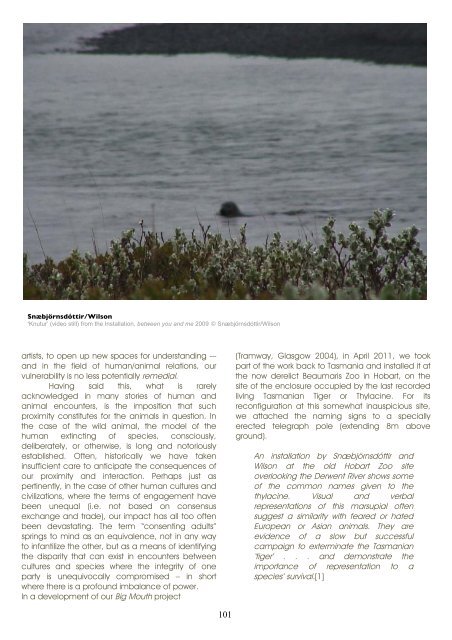Animal Influence I - Antennae The Journal of Nature in Visual Culture
Animal Influence I - Antennae The Journal of Nature in Visual Culture
Animal Influence I - Antennae The Journal of Nature in Visual Culture
You also want an ePaper? Increase the reach of your titles
YUMPU automatically turns print PDFs into web optimized ePapers that Google loves.
Snæbjörnsdóttir/Wilson<br />
‘Knutur’ (video still) from the Installation, between you and me 2009 Snæbjörnsdóttir/Wilson<br />
artists, to open up new spaces for understand<strong>in</strong>g –<br />
and <strong>in</strong> the field <strong>of</strong> human/animal relations, our<br />
vulnerability is no less potentially remedial.<br />
Hav<strong>in</strong>g said this, what is rarely<br />
acknowledged <strong>in</strong> many stories <strong>of</strong> human and<br />
animal encounters, is the imposition that such<br />
proximity constitutes for the animals <strong>in</strong> question. In<br />
the case <strong>of</strong> the wild animal, the model <strong>of</strong> the<br />
human ext<strong>in</strong>ct<strong>in</strong>g <strong>of</strong> species, consciously,<br />
deliberately, or otherwise, is long and notoriously<br />
established. Often, historically we have taken<br />
<strong>in</strong>sufficient care to anticipate the consequences <strong>of</strong><br />
our proximity and <strong>in</strong>teraction. Perhaps just as<br />
pert<strong>in</strong>ently, <strong>in</strong> the case <strong>of</strong> other human cultures and<br />
civilizations, where the terms <strong>of</strong> engagement have<br />
been unequal (i.e. not based on consensus<br />
exchange and trade), our impact has all too <strong>of</strong>ten<br />
been devastat<strong>in</strong>g. <strong>The</strong> term “consent<strong>in</strong>g adults”<br />
spr<strong>in</strong>gs to m<strong>in</strong>d as an equivalence, not <strong>in</strong> any way<br />
to <strong>in</strong>fantilize the other, but as a means <strong>of</strong> identify<strong>in</strong>g<br />
the disparity that can exist <strong>in</strong> encounters between<br />
cultures and species where the <strong>in</strong>tegrity <strong>of</strong> one<br />
party is unequivocally compromised – <strong>in</strong> short<br />
where there is a pr<strong>of</strong>ound imbalance <strong>of</strong> power.<br />
In a development <strong>of</strong> our Big Mouth project<br />
101<br />
(Tramway, Glasgow 2004), <strong>in</strong> April 2011, we took<br />
part <strong>of</strong> the work back to Tasmania and <strong>in</strong>stalled it at<br />
the now derelict Beaumaris Zoo <strong>in</strong> Hobart, on the<br />
site <strong>of</strong> the enclosure occupied by the last recorded<br />
liv<strong>in</strong>g Tasmanian Tiger or Thylac<strong>in</strong>e. For its<br />
reconfiguration at this somewhat <strong>in</strong>auspicious site,<br />
we attached the nam<strong>in</strong>g signs to a specially<br />
erected telegraph pole (extend<strong>in</strong>g 8m above<br />
ground).<br />
An <strong>in</strong>stallation by Snæbjörnsdóttir and<br />
Wilson at the old Hobart Zoo site<br />
overlook<strong>in</strong>g the Derwent River shows some<br />
<strong>of</strong> the common names given to the<br />
thylac<strong>in</strong>e. <strong>Visual</strong> and verbal<br />
representations <strong>of</strong> this marsupial <strong>of</strong>ten<br />
suggest a similarity with feared or hated<br />
European or Asian animals. <strong>The</strong>y are<br />
evidence <strong>of</strong> a slow but successful<br />
campaign to exterm<strong>in</strong>ate the Tasmanian<br />
‘tiger’ . . . and demonstrate the<br />
importance <strong>of</strong> representation to a<br />
species’ survival.[1]












